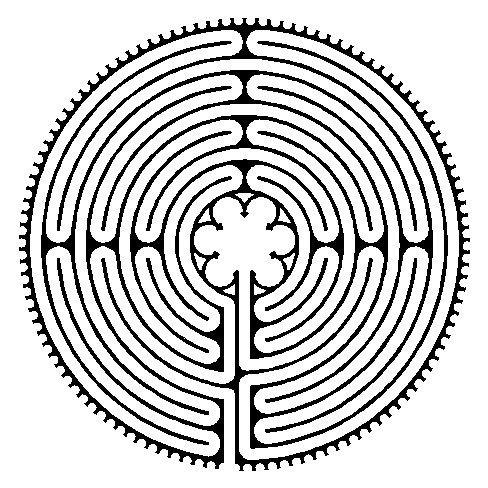TurnAround Support
A Spiritual Tool for Transformation
The Labyrinth
About Labyrinths
The labyrinth is an ancient pattern found in many cultures around the world. Labyrinth designs were found on pottery, tablets and tiles date as far back as 4000 years. Many patterns are based on spirals from nature. In Native American culture it is called the Medicine Wheel and Man in the Maze. The Celts described it as the Never Ending Circle. It is also called the Kabala in mystical Judaism. One feature they all share is that they have one path that winds in a circuitous way to the center.
Labyrinths are currently being used worldwide as a way to quiet the mind, find balance, and encourage meditation, insight and celebration. They are open to all people as a non-denominational, cross-cultural tool of well-being.
Labyrinths and mazes have often been confused. When most people hear of a labyrinth they think of a maze. A labyrinth is not a maze. A maze is like a puzzle to be solved. It has twists, turns, and blind alleys. It is a left-brain task that requires logical, sequential, analytical activity to find the correct path into the maze and out.
A labyrinth has only one path. It is unicursal. The way in is the way out. There are no blind alleys. The path leads you on a circuitous path to the center and out again.
A labyrinth is a right brain task. It involves intuition, creativity, and imagery. With a maze many choices must be made and an active mind is needed to solve the problem of finding the center. With a labyrinth there is only one choice to be made. The choice is to enter or not. A more passive, receptive mindset is needed. The choice is whether or not to walk a spiritual path.
At its most basic level the labyrinth is a metaphor for the journey to the centre of your deepest self and back out into the world with a broadened understanding of who you are.
The person walking it uses the same path to return and the entrance
then becomes the exit. The path is in full view, which allows a person
to be quiet and focus internally. Generally there are three stages to
the walk:
1. Releasing on the way in,
2. Receiving in the centre and
3. Returning; that is, taking back out into the world that which you have received.
There is no right way or wrong way to walk a labyrinth.
There are many ways to describe a labyrinth. It is a path of prayer, a walking meditation, a crucible of change, a watering hole for the spirit and a mirror of the soul.
Most common Types of Labyrinths.

The Classical 7-circuit Labyrinth. - It is sometimes
referred to as the Cretan labyrinth, referring to its ancient and
mythological association with the island of Crete. It is called the
7-circuit labyrinth with regards to the number of concentric paths.
Classical patterns also exist in 11-circuit and even 15- and 19-circuit
versions.

The Medieval or Chartres Labyrinth.
During the Middle Ages, many Gothic cathedrals inlaid labyrinth patterns into their stone floors. Based on principles of sacred geometry and proportion, the following pattern still remains in Chartres Cathedral, France, where it was built in the year 1201. This pattern has been undergoing a popular revival, led by the activities at Grace Cathedral in San Francisco.
The use of the labyrinth as a walking meditation is being revived
in western cultures, particularly the US, where permanent labyrinths
have been installed in settings, such as churches, hospitals, schools
and prisons, along with many outdoor labyrinths being constructed in
public spaces.
My business Turnaround Support Pty Ltd is able to bring the experience of the Labyrinth by way of the transportable canvas Chartres Labyrinth. It is a 12-metre diametre piece and is most suitable for workshops or public open walk sessions.
My personal experience is that it is a means to quiet the mind, reduce stress and re-gain focus. It integrates the body, mind and spirit and is a useful tool for “failed mediators” , that is, those who find it difficult to switch off. By walking purposefully in the ancient pattern a peace is achieved.